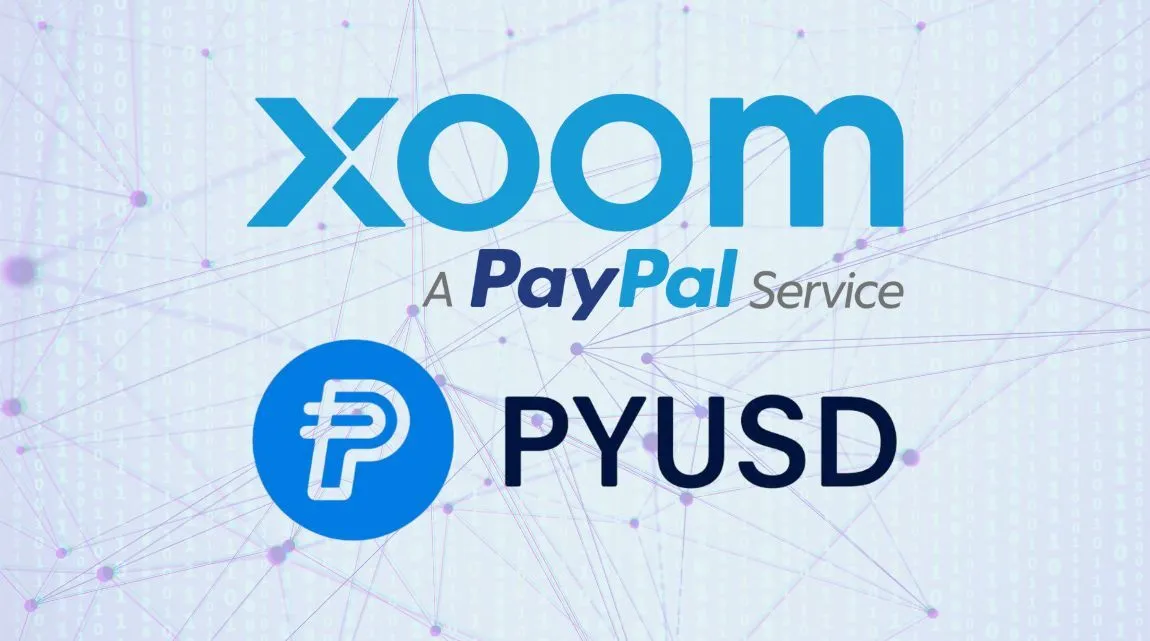PayPal has announced a rare major change to its Xoom remittances brand: the introduction of fee-free money transfers using its stablecoin PYUSD. Can the initiative grow the previously neglected brand?
After years of paying little attention to Xoom, PayPal has announced that it will shortly be adding stablecoin-based remittance services using its US dollar-backed digital currency PayPal USD (PYUSD). These will be offered to customers on a fee-free basis, although Xoom will still charge an FX margin.
The move, which is the most significant product announcement for Xoom in several years, was announced by Jose Fernandez da Ponte, SVP, Blockchain, Crypto and Digital Currencies at PayPal, via an interview with Fortune. In a 9 March post on LinkedIn following the article’s publication, Fernandez da Ponte said that the service would be launched in “weeks”.
“Senders will be able to fund their remittance in PYUSD with no transaction fees, and friends and relatives back home will receive their funds in local currency in their preferred destination – cash pick-up, bank accounts or mobile money wallets,” he added.
“On the receiver side, there is no need to set up different wallets or convert stablecoins into fiat. Same experience, lower cost, making money go further.”
Functioning as PayPal’s primary P2P payment service for customers looking to send to recipients’ bank accounts, cards or for cash pick-up, rather than to other PayPal accounts, Xoom has traditionally priced at the high end of the market. It has also seen lower organic engagement than some other players in the space, making this fee change potentially significant for the brand.
Meanwhile, PayPal is likely to be looking to build use of its PYUSD stablecoin, which was launched in August 2023 through a partnership with issuer Paxos. Xoom rival MoneyGram already has a stablecoin-based remittance service, and has reported settlement benefits using the technology, making this a potentially beneficial approach for PayPal.
With PayPal in the midst of a shift in strategy under new CEO Alex Chriss, and Xoom’s apparent lack of market growth during its nine-year stint as a PayPal brand, can the stablecoin initiative provide a meaningful boost for Xoom and PayPal as a whole?
Xoom at PayPal
Having been acquired by PayPal for $890m in 2015, Xoom has seen considerable growth over the last decade. In 2019 it significantly expanded its receive markets, as well as adding US domestic money transfers, and in 2020 it added domestic send-to-card capabilities via a partnership with Visa Direct. This capability was expanded to cross-border payments in early 2023.
However, while Xoom’s receive markets now sit at slightly above 160 – more than twice the number in 2018 and more than three times their number pre-acquisition – Xoom has seen its focus at PayPal drop significantly over the past few years, with little mention in company communications and little evidence of marketing or customer acquisition investment.
Xoom’s place in the wider remittance market
While there are few direct numbers published around Xoom, search traffic does show that while the company has far fewer visits to its website than Remitly or Western Union, it remains above many of its competitors. However, search-acquired traffic accounts for the lowest share of Xoom’s overall traffic of any of the companies we looked at, indicating that the company is not prioritising customer acquisition from external organic sources.
This appears to suggest that Xoom’s main source of inbound customers is PayPal itself, which uses the service to augment its extensive P2P payments service. When customers want to send a payment within PayPal, they can use the company to send money directly to other PayPal users anywhere in the world using their PayPal account information.
However, if they wish to send money to someone outside of the PayPal ecosystem, they are directed to Xoom, from which they can initiate a payment to a recipient’s bank account, to collect in cash or through another payout method. This may explain why PayPal ultimately did not sell Xoom in 2023, despite reports suggesting that the company was exploring a sale amid investor pressure. It nevertheless presents a situation where Xoom has significant room to grow.
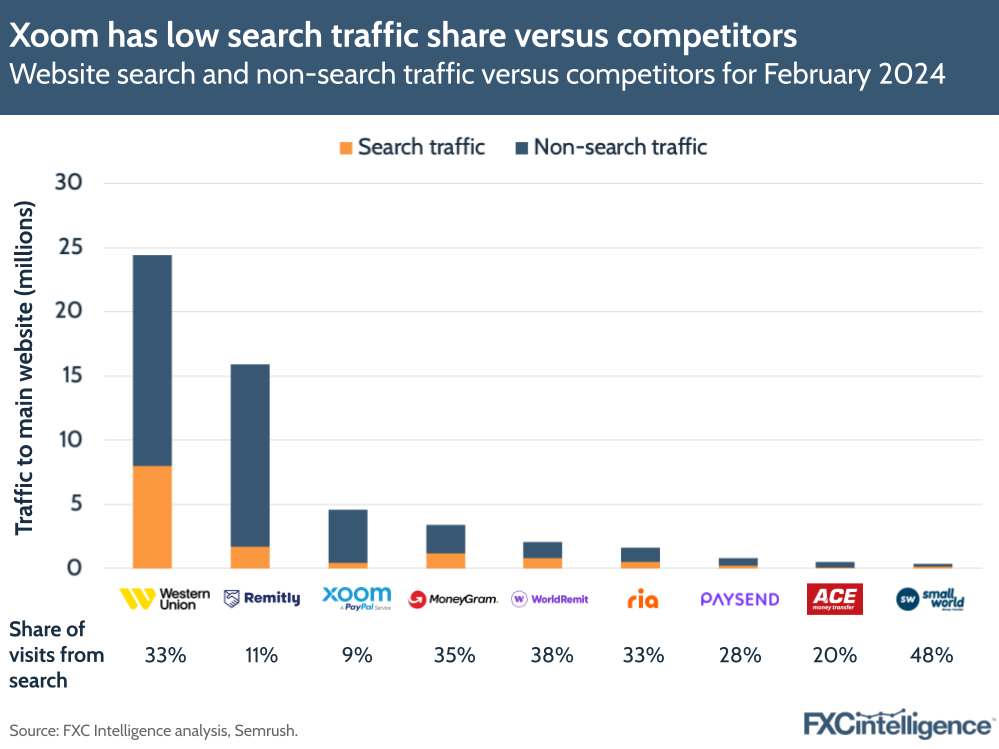
A lack of attention from PayPal
Despite this use of Xoom as an alternative P2P payment method, the brand has seen a significant deprioritisation in focus from PayPal since the ecommerce giant acquired the remittance player.
While Xoom was mentioned regularly in press releases in the first few years after the acquisition, and was included in the standard PayPal bio, this had dropped significantly by 2020, and in 2021 the company made no mention of Xoom at all. Since then, it has been included in less than 10% of company press releases.
A similar trend can be seen in PayPal’s earnings transcripts: Xoom has not been mentioned by name since 2020.
This deprioritization aligns closely with PayPal’s increasing focus on ecommerce during the pandemic under then CEO Dan Schulman, with the company seeing rapid revenue jumps as a result of a significant pivot to online shopping by consumers.
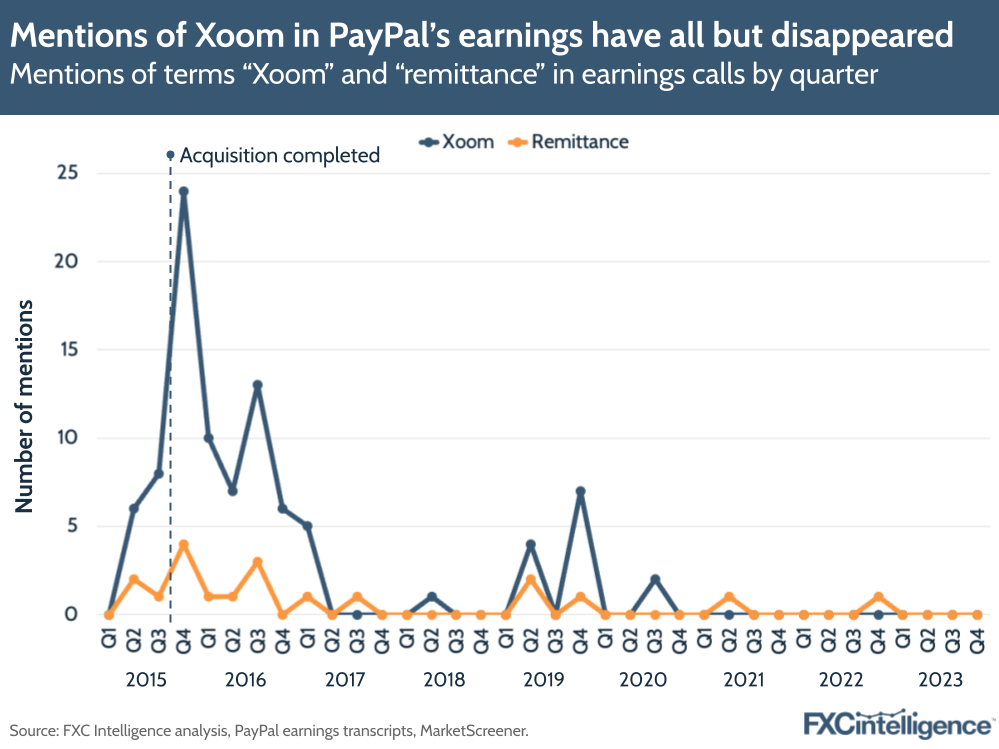
Current volumes and growth potential
However, under new CEO Alex Chriss, who took over in late September 2023, there are signs that PayPal is again broadening its focus to find ways to grow its P2P payments division. While not mentioned by name during the earnings call, Xoom saw its first mention in several years in the supporting documents, with PayPal breaking out its total payments volume (TPV) into business segments for the first time.
Here, Xoom is included under the segment P2P excluding Venmo, which covers both Xoom and P2P payments made within PayPal itself. While the company has not indicated how this segment splits, it has suggested that Xoom makes up the minority of this segment, saying this includes “some contribution from Xoom”.
The company has not stated how much of this volume is cross-border, where it makes much of its revenue, but has stated that cross-border accounted for 12% of all TPV for PayPal in 2023 (down from 13% in 2022 and 16% in 2023). This would make all cross-border volume for 2023 $183bn – more than the entire P2P ex-Venmo segment – of which it has indicated an unspecified minority comes from Xoom.
It is notable that the P2P ex-Venmo segment is not only currently PayPal’s second smallest in terms of volume, but is also one of only two that saw a year-on-year decline, reducing 4% between 2022 and 2023. This is a reflection of the company’s past lack of focus on this division, but also presents an opportunity for Chriss, which the latest announcement may be key to tackling.
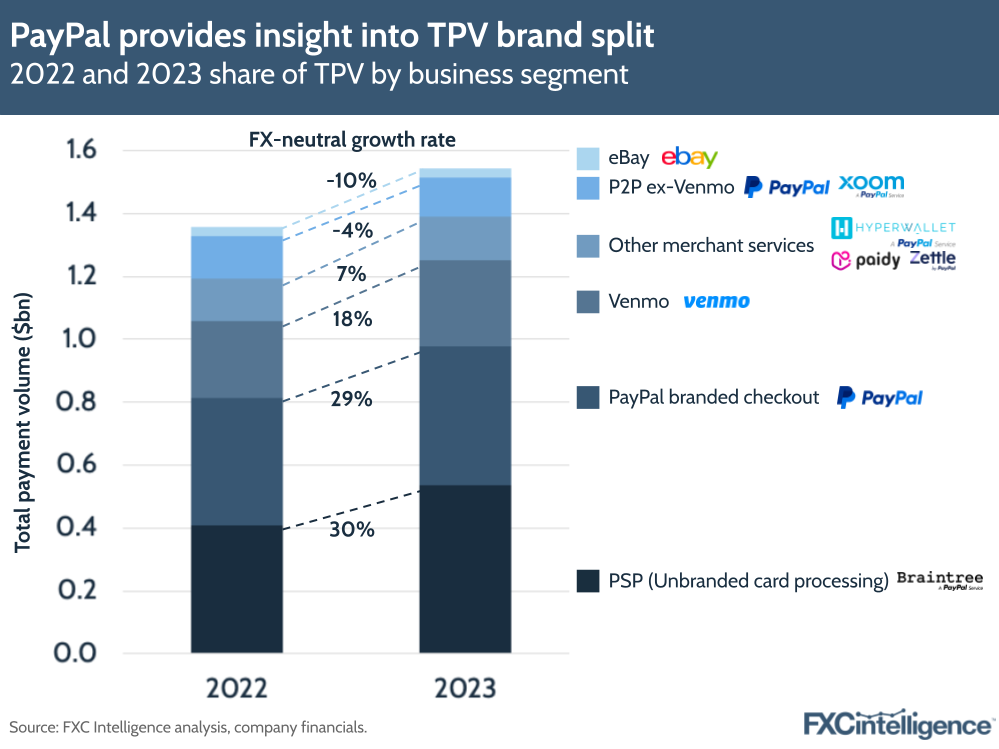
Despite this decline, the figures put the overall segment above the volumes of both leading traditional remittances player Western Union and leading digital money transfers player Wise, highlighting the reach and impact PayPal has. While Xoom is likely to be towards the lower end of the major players, this still shows how strong a potential brand PayPal has in Xoom and its wider P2P money transfers service.
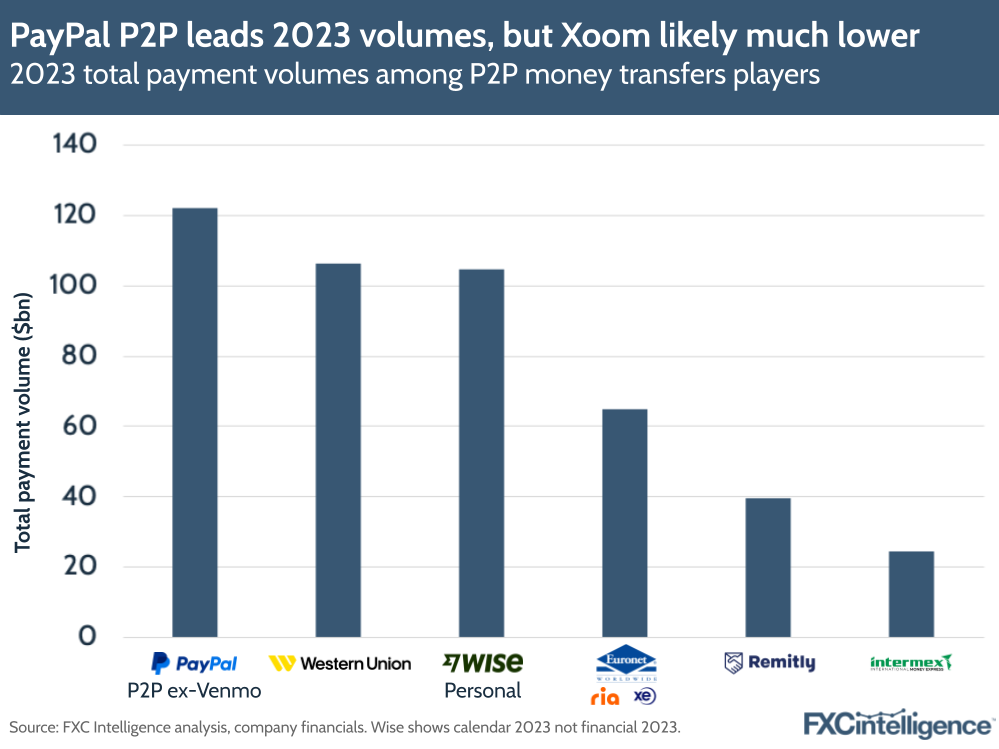
How can remittance market sizing inform my go-to-market strategy?
PYUSD at PayPal
Although less than a year old, PayPal USD has already seen significant uptake within the stablecoin space, and has begun to see limited adoption in other sectors that speak to its longer-term potential.
PYUSD’s development since launch
Since launching, PYUSD has seen a number of different partnerships to broaden its use, initially in the US but since expanding more globally. This includes as an on and off-ramp to allow crypto to be used in real-world purchases, as well as being made available on PayPal’s largely US domestic payments focused P2P platform Venmo.
It has also been added to a number of crypto exchanges around the world, and has been integrated into some systems to enable it to be used for decentralised finance (DeFi) projects.
Included in this has been some early exploration of PYUSD’s potential for remittances, where it is already being used by some international players. Here, companies have highlighted the stablecoin’s benefits of enabling instant FX conversion and transfer, making it a competitive option in some markets.

Growing market capitalisation
Since launch, the number of PYUSD stablecoins in circulation has climbed significantly, growing 579% between August 2023 and January 2024 to reach 301 million, equivalent to $301m, according to mandatory reporting by issuer Paxos.
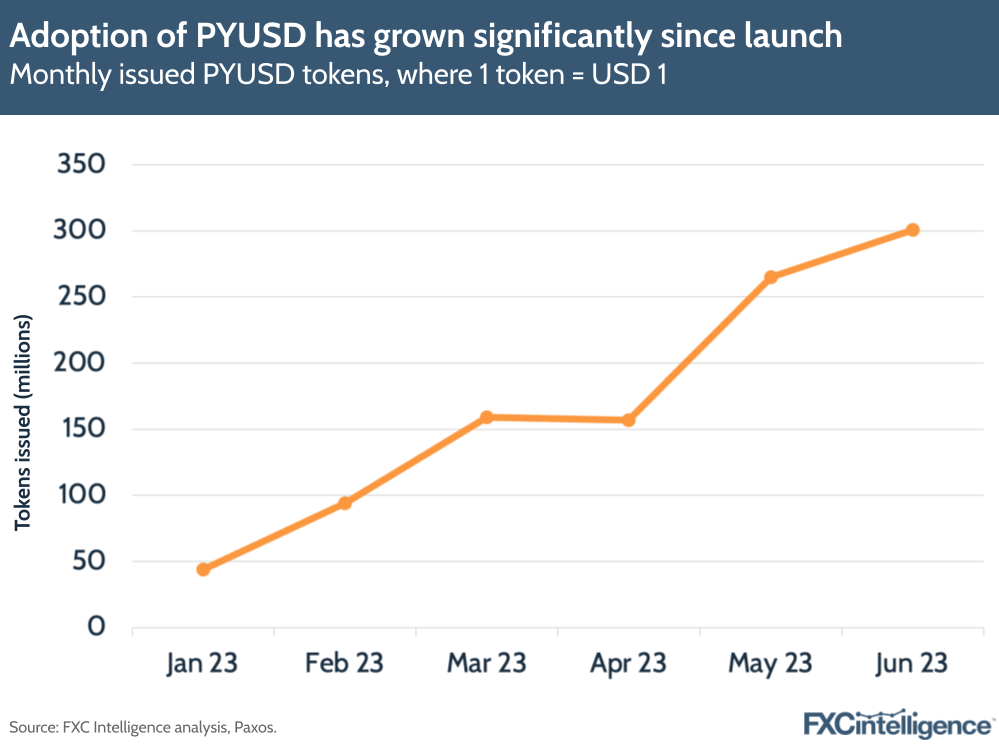
However, while this is significant, it remains far below other stablecoins currently in circulation. PYUSD trails the other major US dollar-pegged stablecoins that are backed by audited assets held in US-based accounts – the conditions stablecoins need to meet for them to have utility in traditional US financial services.
Here, Circle’s USDC stablecoin is the leader, with tokens worth $26.7bn in circulation in January 2024. Paxos’ own stablecoin USDP is also ahead of PYUSD, at $353m, but has seen a drop in use over the last six months and is likely to be surpassed by PayPal within months.
There is also the Paxos-issued Binance USD (BUSD), a stablecoin for cryptocurrency exchange Binance. While this was previously popular, Paxos stopped issuing the coin in February 2023 amid broader US investigations into Binance.
Since then, it has continued reporting on circulation, as owners slowly divest their previous stocks. In August 2023, when PayPal launched PYUSD, BUSD circulation stood at $3.1bn, but in January 2024 it had dropped to $99m.
There is also USDT, one of several stablecoins issued by British Virgin Island-based Tether. Popular as an asset store for crypto traders, USDT has the largest market capitalization of any US dollar-pegged stablecoin – $102bn at the time of writing. However, while it does have audited reserves, these are considered insufficient to comply with US financial standards and so it does not have utility for remittance companies and other fintechs.
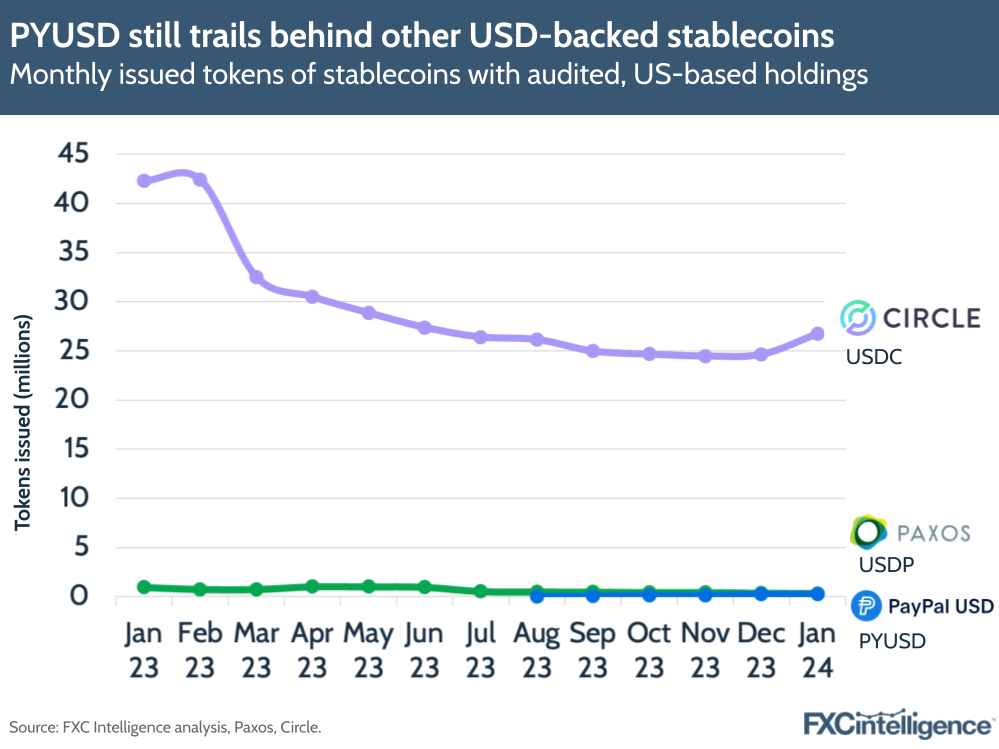
PayPal’s wider crypto holdings
As a stablecoin that holds its value against the US dollar, they are often used as a means of storing value in a cryptocurrency between moving it into other more volatile cryptocurrencies such as Bitcoin. This is favourable to simply converting it back into US dollars or another fiat currency as it does not come with the same on and off-ramp fees.
For PayPal, this was a key reason for launching PYUSD, as it enabled customers to continue to hold money within their ecosystem between crypto purchases.
At the time of launching PYUSD, PayPal already enabled customers in some markets to buy and hold Bitcoin, Bitcoin Cash, Ethereum and Litecoin. Since the launch of PYUSD, PayPal’s reported non-stablecoin crypto holdings for customers have also grown significantly, to reach a combined value of $1.2bn in Q4 2023, over half of which is held in Bitcoin.
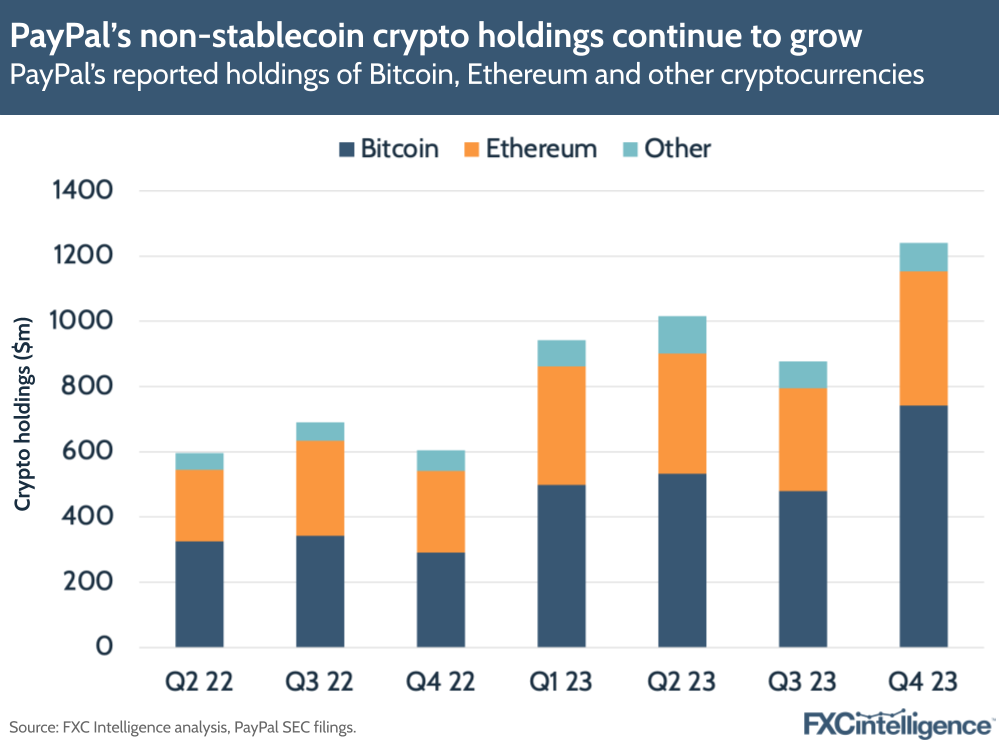
The potential of pairing PYUSD and Xoom
In pairing PYUSD and Xoom, PayPal is joining together two subsidiary brands in a manner that has strong potential for both, as well as providing a broader flywheel effect for its customer base as a whole.
PYUSD and Xoom: Potential synergies
In his post addressing the announcement on LinkedIn, Fernandez da Ponte heralded the pairing of PYUSD and Xoom as an opportunity to bring benefits for the company’s remittance customers.
“Mainstream adoption of digital currencies and stablecoins requires frictionless access for millions of consumers and a reason to adopt,” he wrote.
“We are bringing the promise of stablecoins to remittances right in the same apps and channels where senders and receivers already are, helping them make their money go further to support their families and loved ones.”
For Xoom, the reality is that adding PYUSD, and so providing a lower-cost remittance service than its traditional offering, is likely to serve as a way to attract more price-sensitive customers to its service. Xoom has traditionally priced at the higher end of the market, and has enacted little marketing in recent years to attract new customers.
The introduction of PYUSD gives it a price-focused value proposition that it can use to appeal to new customers, while providing additional appeal to customers who have been acquired via the core PayPal product.
Crucially, however, this is likely to be the first time that many customers encounter PYUSD, creating the opportunity for PayPal to encourage customers to hold onto the stablecoin, or acquire more for ongoing use. While it has not yet released the exact details of how it will handle the process, both send and receive customers could be given the option of holding onto PYUSD as part of the process, either to send on at a later date, use to fund purchases both on and offline or to acquire other cryptocurrencies.
As a result, this move, while beneficial for the Xoom brand, also has the potential to grow adoption of PYUSD further as it continues to broaden its reach, adoption and utility.
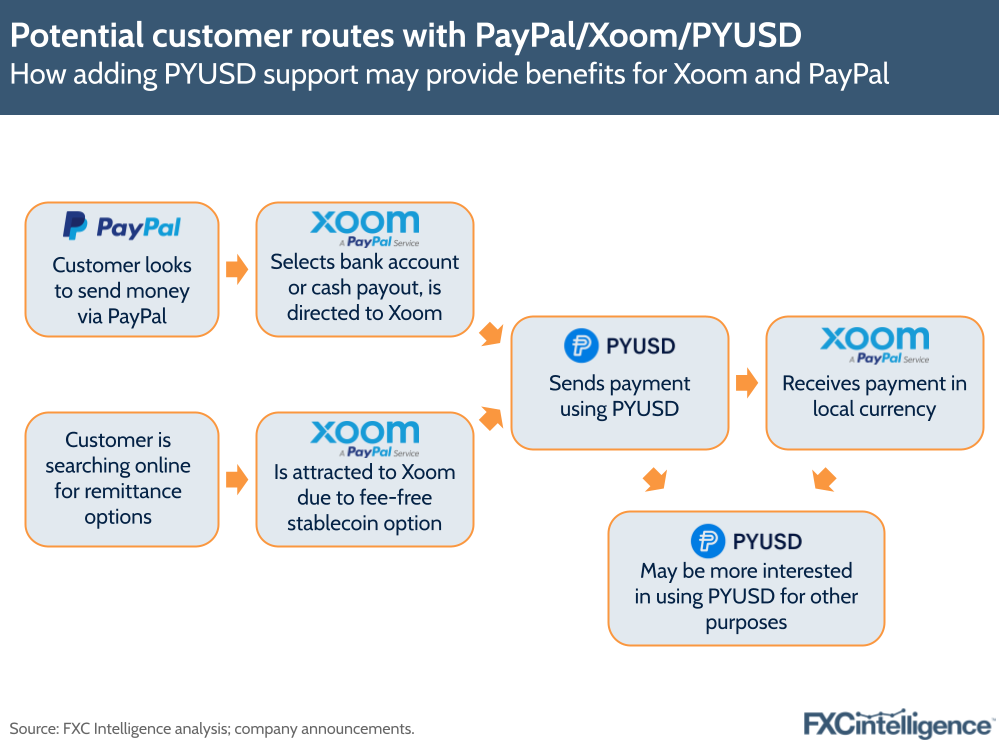
Stablecoins in the remittances industry
While stablecoins remain a fringe solution for remittances, they have seen some adoption at various levels of the industry. Some newer players, such as US-based CFX Labs and Argentina’s Num Finance, have launched consumer remittances services that are entirely stablecoin-based. Meanwhile other players, including South Korea’s Shinhan Bank, have conducted pilots into the technology to explore how it would offer benefits over other solutions.
However, the highest-profile player currently offering stablecoin-based remittances is MoneyGram, which enables customers to purchase and send USDC stablecoin via its retail outlets, in a partnership with Stellar.
What all of these solutions have in common is the technical benefits for the businesses themselves, in the form of settlement. In a traditional remittance offering, the provider will typically pay out the remittance to the customer before the money has arrived in the bank of their local partner in the recipient’s country. The completion of the overall transaction – the settlement – therefore takes longer for the company than it does for the customer.
However, when a stablecoin is used, the settlement is instant, meaning that the company does not have to have excess liquidity to cover the time discrepancy. This can reduce overhead costs for a provider, which in the case of Xoom has enabled it to remove the transfer fees that it charges for its usual service.
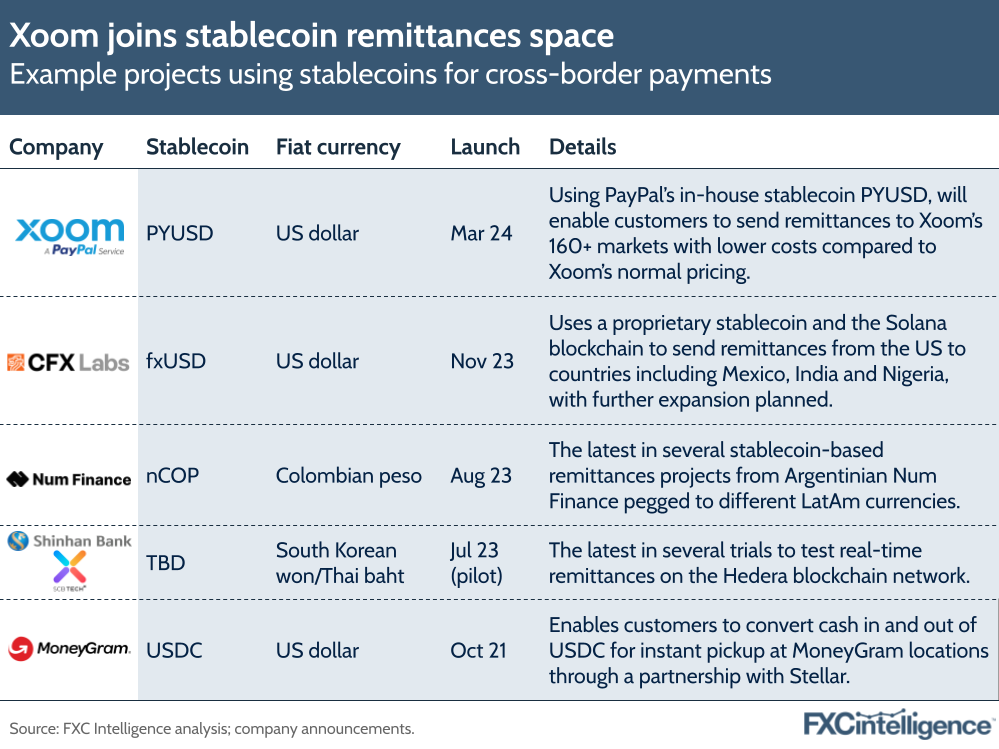
Pricing implications for Xoom
Under its new stablecoin-based system, Xoom is removing transfer fees, but crucially it is not eliminating all costs related to the remittance for the customer. Remittance pricing typically comes in two halves.
The first is the fee margin, which is the percentage a company charges on top of the amount sent to deliver it to the destination – this is the charge Xoom is dropping under this service. However, the second is the FX margin, which is the percentage a company charges on the amount sent to convert it from the send currency to the receive currency. This second charge will remain under Xoom’s new service.
This is likely to result in services that are cheaper than Xoom’s current pricing and may be below overall averages for a given corridor, but which are not the cheapest available for consumers. This would still be a notable change for Xoom, which has traditionally been one of the more expensive services available.
FXC Intelligence’s FX pricing data, which is collected on a granular corridor-level basis for thousands of players including Xoom, shows that the company has also changed its pricing strategy over the last six months. Reviewing pricing on the US to Mexico corridor, the biggest remittance corridor in terms of send volume globally, the fee margin to send $300 used to make up more than half of Xoom’s overall cost to send a remittance, known as the fee margin. However, in the last few months this has dropped to make up around 25% of the overall margin. This suggests that if Xoom were to maintain this pricing strategy, its PYUSD-based transfers would cost around 75% of its traditional remittance transfers.
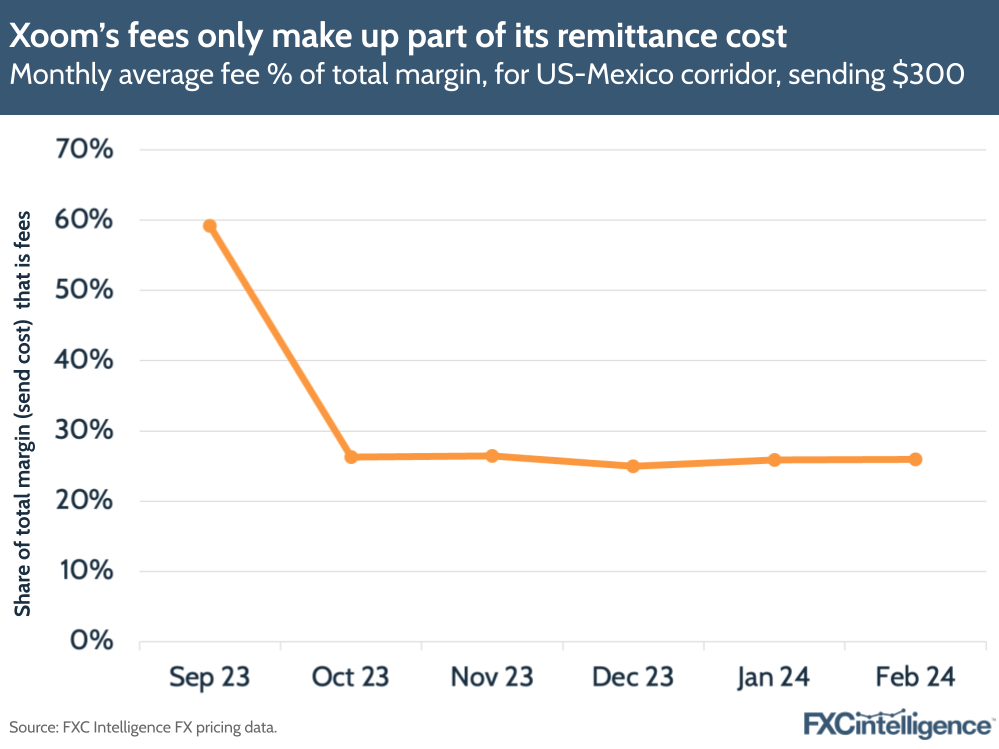
Access the full FX pricing data for Xoom and other leading remittances players
The start of a new strategy?
As CEO Alex Chriss begins to deepen his strategy for PayPal over the next few years, the blending of PYUSD and Xoom presents an opportunity to revitalise the overlooked remittance brand and potentially grow what has become one of PayPal’s smallest business segments.
While it is only early in the process, this announcement, along with the additional volume numbers in PayPal’s results, does indicate that the company is paying more attention to Xoom and exploring how it may increasingly benefit the wider company, rather than regarding it as an asset to maintain and potentially sell off.
It is likely that the launch of PYUSD at Xoom will be accompanied by increased marketing activities and, if handled correctly, could provide something of a relaunch for the remittances player. Here, PayPal has its work cut out for it: it has not updated Xoom’s social media platforms since 2020, and its website similarly has had little added to it over the past few years. However, with the right support this could be a strong differentiator for the platform.
Stablecoins’ role in remittances and the wider money transfers space still remains in question, but a successful integration in Xoom could be key to its future use in the industry.
